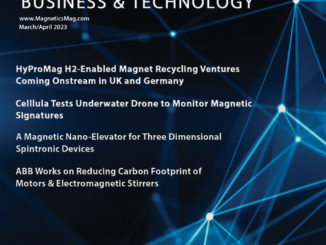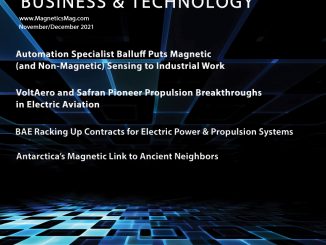By Bridgeport Magnetics Group, Inc.
Toroidal power transformers utilize ring shaped cores, which are made by winding a continuous strip of grain oriented silicon steel, GOSS, around a cylindrical mandrel. Toroids are more efficient and require less core steel and conductor material than conventional transformers. Material savings often amount to 30 to 50 percent, added to indirect savings on smaller enclosures and associated structure, plus of course years and years of power savings.
 In a toroid, the primary and secondary windings are placed directly on top of one another. In most cases, by completely enclosing the core and due to the close mutual coupling, the voltage drop under load (regulation) is lower than in a conventional transformer. For the same reason, toroids emit minimal magnetic stray field virtually eliminating noise caused by interaction with sheet steel enclosures and adjacent structure, and due to the absence of joints the cores exhibit minimal inherent hum. As a result toroids are much quieter in operation than conventional transformers, a feature, which is gaining importance in case of indoor installation e.g. in an office environment.
In a toroid, the primary and secondary windings are placed directly on top of one another. In most cases, by completely enclosing the core and due to the close mutual coupling, the voltage drop under load (regulation) is lower than in a conventional transformer. For the same reason, toroids emit minimal magnetic stray field virtually eliminating noise caused by interaction with sheet steel enclosures and adjacent structure, and due to the absence of joints the cores exhibit minimal inherent hum. As a result toroids are much quieter in operation than conventional transformers, a feature, which is gaining importance in case of indoor installation e.g. in an office environment.
In general toroids are smaller and lighter than equivalent transformers with stacked, laminated cores, but in spite of their potentially better performance relatively few are offered with power ratings above 10 KVA, and practically none above 25 KVA. The reason for this is largely limitations in technology and lack of sophisticated, fully mechanized, heavy duty coil winding equipment. Traditionally, large toroidal winding machines are scaled up versions of the table top machines used to produce smaller transformers, and their architecture and general layout impede the loading and handling of heavy cores as well of partly and fully completed transformers weighing up to 300 pounds.
Manufacturing a large toroidal transformer is more labor intensive than its laminated counterpart. The reason for this is difficulties inherent in the winding process, which become harder to overcome as the units grow larger. The main issue is that in a toroid the core cannot be opened or taken apart, and this means that the coils cannot be wound in a separate process and installed later, but must be wound turn for turn into the permanently closed ring cores.
Adding to the complexity, the winding of each coil section requires that the entire length of conductor is first loaded onto a ring shaped magazine surrounding the core section and then transferred onto the core in a second winding process via a system of guides and rollers located on a large diameter ring gear, while maintaining sufficient tension to secure that the windings are tight and placed precisely onto the core.
Manufacturing a toroidal transformer is usually done in stages, requiring the core to be placed in the machine for winding the first set of coils and then removed for termination and insulation, after which it is placed back in the machine for winding of a second set of coils, and so on, until all connections and the final insulation are in place. The problem, when manufacturing large heavy transformers is that each insertion into and removal from the winding machine is time consuming and presents a risk of damaging the coils and insulation. In later years attempts have been made to alleviate the problem by adding a separate taping head to the coil winding machine, enabling insulation to be applied without removing the transformer, but the layout of machines still impedes manual work such as forming, stripping and splicing of the terminations, and removal of the finished piece remains a tricky process, often requiring the help of a second operator.
 Another problem special for high power transformers is that the curvature of the core prevents the use of wide foil conductors. As a consequence windings carrying high current must be made from many heavy wires wound individually and connected in parallel. The process is labor intensive and hard on the equipment, and new issues arise when the ratings move up into the 50 to 100 KVA level when just forming and bending the wire as it is wound onto the core becomes a difficult task in itself.
Another problem special for high power transformers is that the curvature of the core prevents the use of wide foil conductors. As a consequence windings carrying high current must be made from many heavy wires wound individually and connected in parallel. The process is labor intensive and hard on the equipment, and new issues arise when the ratings move up into the 50 to 100 KVA level when just forming and bending the wire as it is wound onto the core becomes a difficult task in itself.
The winding torque and the forces involved require large dimensioned, high strength components, meaning that the combined weight of the ring magazine and its load can easily amount to 50 pounds or more and, due to variations in angular velocity inertial forces come into play, causing variation in winding tension while winding onto rectangular core sections. The tension may easily snap light wire gauges and often requires that the winding process is slowed down as far as 60 turns per minute or less.
The companies behind Bridgeport Magnetics Group were founded around toroidal technology and, since 1982, have developed proprietary equipment used in the manufacturing of toroidal cores and transformers. The group recently rolled out its third generation of powerful gearhead winding machines, able to handle heavy, rectangular conductors used in power distribution transformers rated up to 100 KVA.
High power toroids are used in a variety of fields including line power distribution, UPS systems and inverters for wind and solar power, as well as in 400 Hz systems for air and seaborne applications. They are also used to create isolation between circuits in order to eliminate the risk of hazardous leakage currents in health care facilities, and as marine isolation transformers on vessels hooked up to shore power. They are used on train cars and for low voltage power distribution in new construction and on job sites. A developing field is in sub stations placed on floating docks in marinas, where features like low weight and a small footprint are at a premium.
 A growing number of high power toroids are used in three phase assemblies, each comprising three single phase transformers, which can be configured and mounted in various fashions, providing superior flexibility in systems layout. They can be mounted flat, in a triangular or in-line pattern, coaxially on cradles or spaced apart on a common rod, enabling convection or forced air cooling if required.
A growing number of high power toroids are used in three phase assemblies, each comprising three single phase transformers, which can be configured and mounted in various fashions, providing superior flexibility in systems layout. They can be mounted flat, in a triangular or in-line pattern, coaxially on cradles or spaced apart on a common rod, enabling convection or forced air cooling if required.
Because three phase toroid assemblies comprise individual transformers the cores do not utilize flux sharing like in conventional E-core designs and often will exhibit improved performance in the case of unbalanced load, while saving some money on harmonics mitigation.
The insulation system is class F (155°C), and the designs meet Federal Energy conservation standards for Dry-Type Low-Voltage Distribution transformers at 80°C temperature rise.
For more information visit www.bridgeportmagnetics.com



